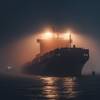Mud dredged from the bottom of harbors to keep ship commerce flowing is loaded with contaminants like dioxin and mercury, creating a sleeping giant of an environmental mess in America's oceans and waterways, water protection groups said.
Scientists and environmentalists demanded that better government protections be employed to protect human health, fish and ecosystems from toxic harbor mud, and called for an immediate ban on the dumping of contaminated sediments.
Every year 100 ocean dump sites receive 60 million tons of dredged harbor mud, equivalent to six million dump trucks of mud. Another 400 million tons of sediments are dumped into rivers, lakes, bays and estuaries, according to Clean Ocean Action and Coast Alliance interest groups.
"The most dangerous offenders of the industrial age have wound up in the mud below, yet the Environmental Protection Agency and Army Corps of Engineers persist in dumping untreated sediments into America's oceans and rivers," said Beth Millemann, an advocate from Clean Ocean Action.
Groups said the EPA has evidence contaminated sediments caused tumors, cancers and skin lesions in fish that came into contact with polluted mud in Elizabeth River, Virginia, San Francisco Bay, Boston Harbor, the Great Lakes and other waters.
Women who ate fish contaminated with dangerous PCBs from the bottom mud in the Great Lakes have given birth to babies with smaller heads and weight deficiencies, the groups said.
"As long as EPA fails to issue protective criteria, people and wildlife will continue to eat fish contaminated with toxics from sediments, making chemical exposure and health effects a fact of life," said Jackie Savitz, executive director of Coast Alliance.
The EPA estimates that more one billion tons of contaminated sediments lie below waterways, and every major harbor suffers from polluted mud. Still, the groups said the EPA has not tightened rules to prevent more pollution in the water.
An official with the agency said the EPA puts ocean protection at the top of its priority list when weighing waterway policy.
"Protecting the ocean and costal environment is an EPA priority. When making decisions about ocean placement of dredged material EPA uses the best available science," said J. Charles Fox, assistant administrator for water at EPA.
"The real solution to dredge material management however, is stopping sediment pollution at its source, whether it be industrial pollution, storm water runoff, sewer overflows or other sources. That is the direction this agency is moving." - (Patrick Connole, Reuters)
Subscribe for
Maritime Reporter E-News
Maritime Reporter E-News is the maritime industry's largest circulation and most authoritative ENews Service, delivered to your Email five times per week










